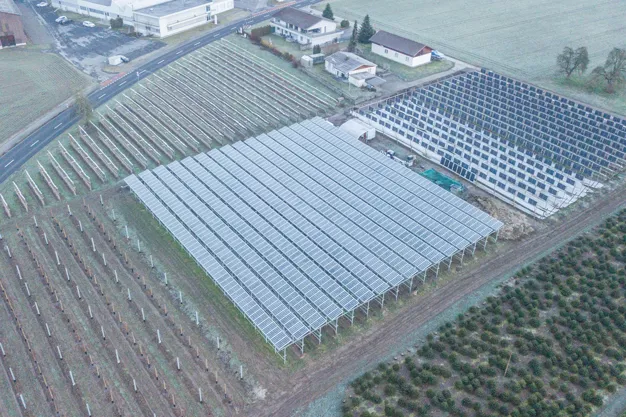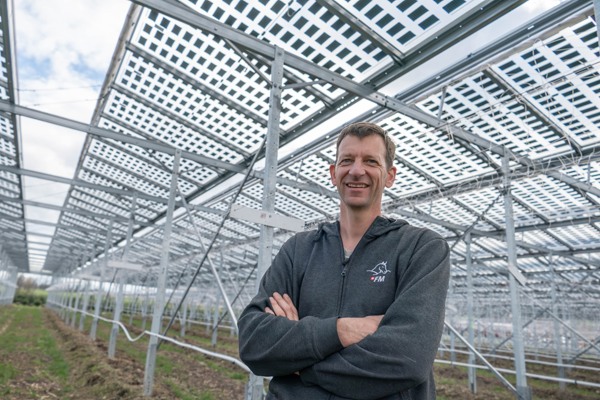Raspberries and solar power on a single plot – FreshPlaza.com
No plant can grow without light. But how much does a raspberry really need to bear fruit? Or can the berry thrive with just half the normal amount of light if the rest is used to produce solar power?
Organic farmer and berry producer Heinz Schmid from Gelflingen, LU, aims to uncover this and much more over the next few years in his 7,200 square-meter pilot facility for Agri-Photovoltaics. He has installed a total of 500 kilowatts (kW) of solar power capacity there. For comparison, an average solar system on a single-family home has about 10 kW.
The “solar” raspberry plantation is prominently located on the connecting road between Mosen and Aesch in the Lucerne Seetal. These weeks, the final steel beams are being driven into the ground, which will soon support movable solar modules, ensuring the raspberries below receive enough light.
Heinz Schmid has deliberately installed three very different types of Agri-PV systems. “Comparing the various systems will provide us valuable insights for the establishment of Agri-PV in Switzerland,” says Heinz Schmid.
Agri-PV is particularly suited for berries
With its dual use of land for food and electricity production, the Agri-PV concept fits well with current global challenges. It is already much more widespread in other parts of the world than in Switzerland. For example, in Japan, 180 different agricultural crops are already growing in over 3,500 facilities.
In Switzerland, progress is slow, even though the legal situation has improved with the adjustment of the Spatial Planning Ordinance. This has allowed Agri-PV outside of construction zones on crop rotation areas for the past two years, provided it offers additional benefits to agricultural production.
The legislator intended with this clause to prevent large open-field systems from being set up under a green guise in the Swiss landscape. However, this significantly limits the number of possible locations for Agri-PV from the outset. For crops such as wheat, potatoes, vegetables, and even fodder production, yields under the modules are usually significantly lower, as examples from abroad show.
Yet, there is an exception: Professional berry and fruit orchards are already equipped with rain roofs or hail protection nets. These protective functions could also be taken over by solar modules. Moreover, there are indications that the microclimate under the modules can be better controlled. Less humidity, for example, means fewer diseases and lower temperatures in the heat mean more yield. This almost sounds like symbiosis.
Successful search for project partners
The topic of Agri-PV has been on Heinz Schmid’s mind for many years. Although he and his wife Monika primarily earn their income from organic sprouts and berries, he has also been producing solar power on his roofs for many years and plans solar systems for external customers. His interest in Agri-PV is, therefore, obvious, and he has already conducted trials on a smaller scale.
A key moment was meeting people like André Ançay from Agroscope at a berry conference. Ançay is involved with Agri-PV at the research institute Agroscope and is overseeing a multi-year trial on berries at the site in Conthey.
Heinz Schmid launched the project with his company bioschmid Ltd. at the site in Aesch LU in collaboration with the research institute, which collects and analyzes agronomic data.
He brought on board two local technology partners, the Swiss startup Insolight and the solar company Megasol. The Bern University of Applied Sciences HAFL is monitoring the solar power yields of the different systems. The building application to the municipality went unopposed. “I was able to address concerns from an environmental association with a discussion on-site in advance,” says the organic farmer. The project’s innovative character seems to have been sufficiently intriguing for the authorities. He, therefore, received the building permit promptly.
More pilot facilities are needed
Interest in Agri-PV is indeed present, especially among berry and fruit farms in Switzerland, explains Thomas Keel from the Agri-PV working group at the industry association Swissolar upon request. “But many facilities are stuck in the approval process.”
Since there is hardly any experience with Agri-PV facilities in Switzerland, the authorities lack a basis for decision-making. So far, there are only smaller Agri-PV projects in Switzerland, including a test facility covering 2,000 square meters over raspberries and strawberries at Beerenland AG in Walperswil, BE.
Therefore, projects like the one in the Lucerne Seetal are very important, according to Thomas Keel. Moreover, the Agri-PV installations are more expensive than a simple solar system, for example, on a barn roof. However, there is currently no additional financial support for Agri-PV to compensate for the extra costs.
It takes pioneers like Heinz Schmid, who are willing to overcome the high administrative and financial hurdles. To receive the one-time compensation, Heinz Schmid had to participate in the national auction process with his facility size, along with other “normal” large facilities. Although he was awarded the contract for his Agri-PV, this funding covers only a fraction of the total investment costs.
Therefore, he had to secure additional funding sources, such as from the Federal Office of Energy, the Canton of Lucerne, and foundations. In addition, the technology partners are providing financial support, and revenue is generated from the sale of electricity. He supplies this to the local utility company CKW at a currently low market price.

Theoretical potential of Agri-PV in Switzerland
The Zurich University of Applied Sciences (ZHAW) calculated in a feasibility study an annual theoretical potential of 130 TWh of electricity from Agri-PV. This includes several exclusion criteria, such as the distance to the power grid. If a tenth of the potential were utilized in practice, it would require 1.1 percent of the agricultural land (AL) with open arable land or 0.9 percent with permanent crops.
Basic shading of 50 percent
The first two types of facilities went online last year. The raspberries underneath have developed normally, says Heinz Schmid. Final statements can only be made from this year onwards when the facility is fully operational.
The first system type was developed by Heinz Schmid himself. In this system, the solar panels are suspended vertically over the berry facility on wire ropes. A film is attached under the modules, which protects the raspberry crops from rain, as in usual professional facilities. The vertical orientation is intended to make use of the morning and evening sun, with the modules capturing light on both sides. “This solution is likely the most cost-effective of the three applied methods,” explains Heinz Schmid.
In the second system, he uses technology from the Swiss startup Insolight. The steel beams are embedded 1.80 meters deep in the ground and support the special solar modules at a height of 3.5 meters. They are equipped with solar cells only about halfway, allowing enough light for the crops to pass through. The basic shading under the modules is around 50 percent. The facility is equipped with sensors that feed data to sophisticated software. “For example, if the plant reaches the light saturation point, no more photosynthesis takes place,” explains Heinz Schmid. At such moments, the canopy under the modules closes so that they can optimally use the reflected light for additional power production.
Berry production is the focus
Heinz Schmid and his team plant the young plants or canes of the organic raspberries directly into the ground in spring. This includes, among other things, nutrient-rich compost and is covered with a green manure in winter if possible, which maintains the fertility of the soil.
Although Schmid sees himself as a pioneer in introducing Agri-PV to Swiss agriculture, “the production of high-quality raspberries must always be the main focus,” he says. For him, it was therefore important that the project management remained with bioschmid Ltd.: “There’s a risk that external investors might focus too much on selling the electricity with Agri-PV.”
Heinz Schmid is convinced that Agri-PV makes ecological sense: “The scarce land is optimally used for food and energy production without damaging the soil.” For if the whole thing turns out to be a dud in a few years, the facility can be dismantled and the crop rotation area restored to its original state.
Source: www.lid.ch


